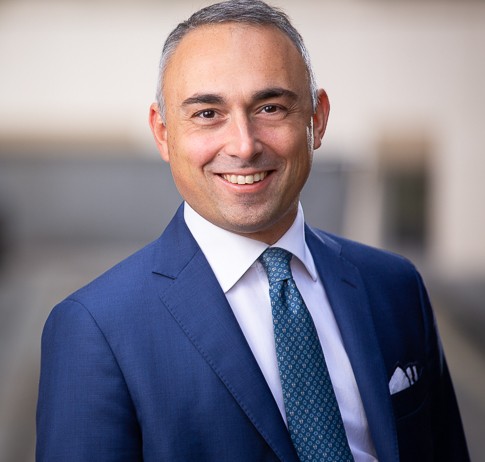Article
Rethinking materials: Meet the innovators closing the loop in fashion and design
16 November 2023 | 3 minute read
Growing up in India, twins Uddhav and Vaidehi Bagrodia loved to visit their family’s textile factory. They would watch yarn being made, see sweaters being knit, and play games with the large piles of waste fibre left on the floor.

“It was fun to play with as kids but as we grew older, we realised: ‘Hold on, this is waste output’,” says Uddhav. “There is waste created when you make yarn, there is waste created when you make fabric, and there is more waste when you make a garment and of course when a consumer discards clothing. Industry-wide, that is a huge problem.”
In 2017 the twins moved to the United States as undergraduates – Vaidehi at the Fashion Institute of Technology in New York, Uddhav at Babson College – and began to apply what they were learning about fashion, innovation and sustainability to their existing knowledge of manufacturing. “We started doing some research and development work, working out how to recycle waste materials and used clothing by spinning it back into yarn,” says Uddhav.
With WASTEWEAR, we are using only waste to create our products: no new inputs or outputs. That’s what it means to close the loop.
Within a year, the pair had a product and process they were satisfied with, and decided to found their own closed-loop recycling brand, WASTEWEAR™. The business creates fabric from recycled plastic bottles, consumer and industrial textile waste and turns it into products such as tote bags and T-shirts. Its customer base includes eco-conscious consumers as well as wholesale clients looking for staff uniforms or event giveaway items.
WASTEWEAR has also been approached by some well-known US labels that are interested in its work, although Uddhav believes many others are yet to live up to their public commitments to the planet. “Everyone is talking about circularity now but in the West, where the big brands are based, there is still low awareness as to what is really sustainable and what’s just greenwashing,” he says. “With WASTEWEAR, we are using only waste to create our products: no new inputs or outputs. That’s what it means to close the loop.”

Coline Le Quenven, a French-born artist and designer, agrees awareness is a huge problem – and believes the creative arts have an important role to play in promoting it. Coline began working with plastic waste as a raw material while studying at Central Saint Martins in London. A Swiss luxury watchmaker had asked for ideas for new materials just as the Covid-19 pandemic was surging, and she decided to experiment with the blue plastic masks she was noticing everywhere.
“Most people don’t even know the facts about plastic. They don’t have a full understanding of the life of their plastic bag or products,” she says. “I find it fascinating how quickly we dispose of it, even though it lasts for ever. It’s the craziest material ever.”
The luxury brand wasn’t sure its customers were ready to pay high-end prices for plastic, but the artist had found a compelling medium and narrative. “It’s not pleasant working with plastic but I am super attracted to the colours and transparencies in materials, and the outcome impressed me,” she explains.
It’s really exciting to see young founders building their business on what sustainability means to them.
In the few years since that first project, Coline has produced pieces for exhibitions across Europe, including the Climate Art Collection in Berlin, a show at Dutch Design Week and a commission for Plasticocène in Marseille, for which she spent three weeks collecting plastic from the ocean in Ibiza. To raise awareness around waste she has fashioned plastic into coral and shell shapes, as well as usable objects such as cups and cutlery.
“There are eight billion tonnes of plastic in the world, and we are going to have to find a way to live with it somehow,” she says. “It’s so indestructible that it will never be possible to remove it from the ocean completely. For me art, craft and design is a way to build resilience towards pollution.”

Projects such as WASTEWEAR, then, are particularly important. “It’s really exciting to see young founders building their business on what sustainability means to them and playing their part in trying to bridge the space between responsible business and commerciality which is needed to drive change,” says Graham Webster, a partner in Withers' fashion and brands group. “Everyone knows fast fashion is an enormous challenge for the planet and closed-loop recycling can be a real-world part of the solution.
While the sustainable fashion world is exploring exciting new fabrics made from mushroom fibres and pineapple leaves, they are not yet being produced at anything like the scale that is required – and designers and consumers may find their textures unfamiliar. By contrast, the Bagrodias argue that fashion lovers will not see a difference between their recycled yarn and virgin materials. This is likely why big fashion brands are beginning to adopt recycling.
In the past couple of years I’ve seen a big change in how the fashion industry values sustainability.
“Ralph Lauren, Tommy Hilfiger and Levi’s have all started using some recycled materials,” notes Uddhav. “H&M is using recycled materials in their products, a small percentage, but they’ve made a start.”
The main barrier to closed-loop recycling being adopted more widely is that it is still more expensive than producing virgin cotton, there is also limited expertise in working with recycled fibres and understanding cost and quality opportunities. That is a critical issue for brands that are focused on every percentage point of costs. However, the Withers fashion team believe that influential investors are beginning to shift their focus away from pure profit.
.jpg)
"Over the past few years we’ve seen sustainability become a more focussed metric for investors, although the concept can still be amorphous and there is an increasing awareness of green-washing and lip service,” says Graham. "At its heart, the concept of what constitutes capital 'doing good' remains a largely personal decision, influenced by an individual's own perception of sustainability and the wider financial context in which they operate. But the positive link between that perception of sustainability and investment return is getting stronger.”
Indeed, the recent valuation of Vinted, Europe’s biggest online marketplace for used clothes, at €3.5 billion has led some to talk of a sustainable fashion boom. “In the past couple of years I’ve seen a big change in how the fashion industry values sustainability. They are beginning to work with recycled materials a lot more; even down to using recycled plastic rails in stores,” says Coline Le Quenven. “Of course, some big companies are still more worried about money, but I think individuals’ mindset is changing for good. I’m pretty sure of that.”
The Global Rethinkers
We're getting behind the innovators in fashion, beauty and retail. Check out our hub to find out more.






